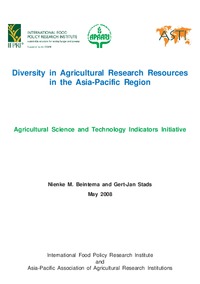Authors:
Beintema, Nienke; Stads, Gert-Jan
Year:
2008
Publisher
International Food Policy Research Institute (IFPRI); and Asia-Pacific Association of Agricultural Research Institutions (APAARI)
Back to:
The Asia-Pacific region is highly diverse in terms of geography; population distribution; economic development; and cultural, political, and historic backgrounds. With over 30 distinct countries, the region comprises about 60 percent of the world’s population, including more than half of the world’s poor (IFPRI/ADB 2007). Asevidenced above, this high level of diversity is also reflected in the region’s agricultural R&D efforts. In 2002, the Asia-Pacific region as a whole, including highincome countries, spent $9.6 billion on agricultural R&D (in 2005 international prices). Unsurprisingly, distribution of spending among countries was very uneven,
with China, Japan, and India accounting for a combined total of about 70 percent of the region’s spending. Regional investments as a whole grew by 3.0 percent per year during 1981-2002. Most of this growth took place in the last decade, when China and India in particular accelerated their agricultural research spending. Some of the smaller countries such as Malaysia and Vietnam also realized impressive growth in agricultural R&D spending in recent years, whereas growth in countries like
Pakistan, Indonesia, and Laos was more sluggish (and in some cases negative), for a variety of reasons including the Asian financial crisis, the completion of large
donor-financed projects, and mass inflation.
A similar diversity exists across countries in the region’s human resource capacity in agricultural R&D. With over 50,000 agricultural fte researchers, China has by far the highest capacity. In contrast, agricultural research systems of countries like Laos and Papua New Guinea employed just over 100 fte’s. Average degree levels of agricultural research staff also differ widely, with India having the region’s (if not the developing world’s) most highly qualified research staff. More than half of the country’s agricultural researchers were trained to the PhD level in 2003. Average degree levels in countries with a history of political isolation, such as Vietnam and Laos, are much lower. Nonetheless, all countries in the survey sample improved the capacity of their agricultural scientists in terms of higher education over the past decade, despite widespread challenges facing certain countries in terms of attracting and keeping well-qualified staff. Large gender discrepancies are prevalent in staff composition as well. While the Philippines reported an uncommonly high ratio of female research staff (4 of every 10 agricultural scientists) Pakistan recorded an extremely low share (only 6 in 100 agricultural researchers are female).
Although the bulk of Asian agricultural R&D is still financed by national governments, many countries raised agricultural research revenues through other means. Competitive funding mechanisms, internally generated resources, and production or export levies, among others, have all gained prominence across the region. Donor dependency for the Asia-Pacific region as a whole is much lower than in Sub-Saharan Africa, although it remains extremely high in countries like Laos and Nepal. The private sector has also become more involved in financing public agricultural research in certain countries. In addition to financing public research, the private sector in some Asia-Pacific countries has also become more active in conducting agricultural research. In countries like Indonesia and the Philippines, close to 20 percent of all agricultural R&D investments were made by the private sector in 2002/03. In many other countries, however, the investment climate for private investors is poor, making private investments in agricultural R&D negligible and often non-existent.
Overall, some of the region’s countries have well-managed and well-funded systems producing world-class research, while others (some of which are highly agriculture-dependent) have experienced significant declines in their R&D spending and research intensity levels. Sustainable financial and political support for agricultural R&D is crucial, as is the creation of attractive investment climates for private investors, if the challenges of sustainable economic and social development facing the region are to be met.

